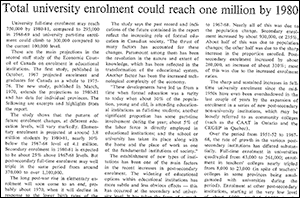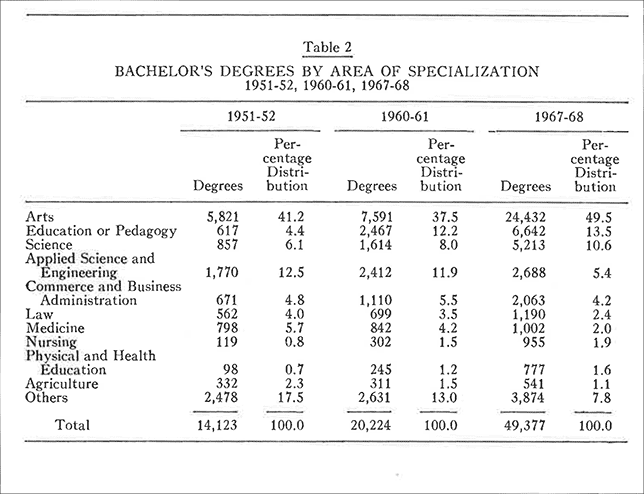By UA staff
Published May 1970
University full-time enrolment may reach 750,000 by 1980-81, compared to 293,000 in 1968-69, and university part-time enrolment could climb to 300,000 compared to the current 100,000 level.
 These are the main projections in the second staff study of the Economic Council of Canada on enrolment in educational institutions. The first study, published in October 1967, projected enrolment and graduates for Canada as a whole to 1975-76. The new study, published in March 1970, extends the projections to 1980-81 and has data for individual provinces. The following are excerpts and highlights from the report.
These are the main projections in the second staff study of the Economic Council of Canada on enrolment in educational institutions. The first study, published in October 1967, projected enrolment and graduates for Canada as a whole to 1975-76. The new study, published in March 1970, extends the projections to 1980-81 and has data for individual provinces. The following are excerpts and highlights from the report.
The study shows that the pattern of future enrolment changes, at different education levels, will vary markedly. Elementary enrolment is projected at around 3.8 million students by 1980-81, nearly 10% below the 1967-68 level of 4.1 million. Secondary enrolment in 1980-81 is expected to be about 25% above 1967-68 levels. But postsecondary full-time enrolment may well triple in the same period from around 370,000 to over 1,100,000.
The long post-war rise in elementary enrolment will soon come to an end, probably about 1970, when it will decline in response to the lower birth rates of the 1960s. Secondary enrolment will continue to increase for a few years but is expected to reach a peak around 1975.
Post-secondary full-time enrolment is expected to be still increasing by 1980-81 but at a much slower rate than is now the case. Annual rates of increase may be down to less than 5% compared with current rates of around 15 % . Postsecondary full-time enrolment levels should stabilize in the latter part of the 1980s and may then even begin to decline in response to the birth decline of the 1960s. (See table 1).
By 1980 it may well be about as common for young people to continue on to universities and community colleges as it was in 1950 to attend high school. Almost half of the population 18-21 years of age may well be enrolled full-time at the postsecondary undergraduate level.
The study says the past record and indications of the future contained in the report reflect the increasing role of formal education in Canadian society. “The thrust of many factors has accounted for these changes. Paramount among them has been the revolution in the nature and extent of knowledge, which has been reflected in the transformation of the educational system. Another factor has been the increased technological complexity of the economy.
“These developments have led us from a time when formal education was a rarity to today when about 30% of the population, young and old, is attending educational institutions as full-time students; another significant proportion has some part-time involvement during the year; about 5% of the labor force is directly employed in educational institutions; and the school or university has taken its place along with the home and the place of work as one of the fundamental institutions of society.”
The establishment of new types of institutions has been one of the main factors in the recent increases in post-secondary enrolment. The widening of educational options within educational institutions has more subtle and less obvious effects – this has occurred at the secondary and university level. It has taken the form of a much wider distribution among Canadian universities of courses that, a few years ago, may have existed only in a single or a few universities. There has also been a pronounced expansion of programs of study that once existed only in a rudimentary form. In addition, new universities have been established, bringing the university to the doorsteps of more students. A greater number of student bursaries and loans have become available. This whole pattern of development has naturally served to make university educational opportunities more available to students and served to reinforce the rising enrolment trends.

National Enrolment Trends
Elementary enrolment increased by about 1.9 million students, or 85%, from 1951-52 to 1967-68. Nearly all of this was due to the population change. Secondary enrolment increased by about 930,000, or 235%. About half of this was due to population changes; the other half was due to the sharp increase in the proportion enrolled. Postsecondary enrolment increased by about 280,000, an increase of about 310%; most of this was due to the increased enrolment ratios.
The sharp and sustained increases in full-time university enrolment since the mid-1950s have even been overshadowed in the last couple of years by the expansion of enrolment in a series of new post-secondary non-university institutions, which may be loosely referred to as community colleges (such as the CAAT in Ontario and the CEGEP in Quebec).
Over the period from 1951-52 to 1967-68, the rate of growth in the various postsecondary institutions has differed substantially. Full-time enrolment in universities quadrupled from 63,000 to 261,000; enrolment in teachers’ colleges nearly tripled from 8,000 to 23,000 (in spite of teachers’ colleges in some provinces being amalgamated with universities during the period). Enrolment at other postsecondary institutions, starting at the very low level of about 4,000, reached 64,000 in the period, increasing at the highest rate of all in relative terms.
Part-time enrolment at the university level has increased even more spectacularly from about 4,100 to almost 100,000 in 1967-68. Most of the increase in postsecondary enrolment has taken place in the 1960s. University full-time enrolment has more than doubled in only six years from 1961-62 to 1967-68, and full-time enrolment at technical institutes and community colleges more than doubled in only three years.
The strong upward thrust of postsecondary enrolment has continued since 1967-68. Preliminary data for the 1968-69 term indicate that total full-time enrolment reached 423,000, an increase of 14% over the previous year. While data for the 1969- 70 term are not yet complete, preliminary reports from provincial authorities suggest an increase in excess of 15% .
In examining the postsecondary enrolment prospects in 1980-81, the study pointed out that trends in ratios are clearly upward, but it is hazardous to predict future rates of increase. Nevertheless the report says a doubling of post-secondary enrolment ratios from 16% in 1967-68 to 33% in 1980-81 seems to be indicated. This, together with a projected increase of nearly 50% in the 18-24 age group, would lead to a tripling of enrolment by 1980-81. The largest relative increases are expected to be in the community colleges, but the largest increase in absolute terms is still expected to be at the university level.
“Frankly it must be acknowledged that the knowledge of the factors determining how many students will attend post-secondary educational institutions at any given time is not very precise. Under such conditions a variation of 10 or 15% either above or below the projected enrolment ratio would not be surprising”.
The study also shows that the university full-time enrolment ratio in Canada (as a percentage of the 18-24 age group) has narrowed compared to the United States. In 1956-57 it was about 6% in Canada and 14% in the U.S. By 1967-68 the ratio in Canada had risen to a point somewhat over half the comparable U.S. rate and the projection to 1975 shows that the ratios in Canada will have risen to about three-quarters that in the U.S.
Other interesting breakdowns and trends are evident in the report:
Enrolment by Sex
The proportion of female students at university has been increasing steadily. Although still in a decided minority, female full-time university enrolment (including teachers’ colleges) has risen from about 28% of the total in 1951-52, to 36% in 1967-68. Female enrolment ratios have, therefore, been rising even faster in relative terms than those for males – as a percentage of the 18-24 age group, more than tripling compared to more than doubling for males.
Part-time University Enrolment
Full-time university enrolment slightly more than tripled from 1951-52 to 1967-68; part-time enrolment increased 23-fold. Part-time enrolment increased from 6% of total enrolment to about 27% in that period. In general, three part-time students might be regarded as approximately equivalent to one full-time student. In these terms, part-time enrolment amounted to 10% of total full-time equivalent enrolment in 1967-68. The report projects part-time enrolment as increasing from 99,000 in 1967-68 to 298,000 in 1980-81.
University Graduate Enrolment
Graduate enrolment has risen to about 9% of the total in 1-967-68, from about 6% in 1951-52. It is projected to rise to 15% of the total in 1980-81. University graduates with bachelor’s degrees increased by 250% from 1951-52 to 1967-68, those with master’s degrees by about 400% and those with doctor’s degrees by 330%.
Changes in specialization show in the same period. The 24,400 B.A.s awarded in 1967-68 made up half the total bachelor’s degrees awarded – in 1951-52 the proportion was 41 %. But a more important shift has been from the Applied Natural Sciences (of which Engineering and Agriculture are the two major categories) and Health Sciences and Services sector to Education and Pure Science. (see table 2).
Applied Science and Engineering graduates in 1951-52 outnumbered Education graduates by almost three times; by 1967- 68 the situation was almost exactly reversed – Education graduates were almost three times Engineering graduates. Similarly, Science graduates in 1951-52 were less than half the Applied Science and Engineering graduates – in 1967-68 they were double. Part of the increase in Education degrees is accounted for by the closing-out of teachers’ colleges in many provinces and the substitution of university courses.
The projection of post-secondary graduates to 1980-81 shows that non-university graduates will probably increase by more than tenfold to 106,200 students and the total of university graduates at all levels will increase to 250,000.

(Enrolment in Educational Institutions by Province, 1951-52 lo 1980-81, by Z. E. Zsigmond and C. J. Wenaas, Economic Council of Canada, Staff Study No. 25, Ottawa, Queen’s Printer, 1970, $3.00.)